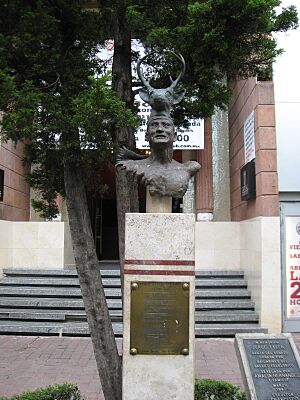Yaqui music facts for kids

Yaqui music is the special sound of the Yaqui people. They live in parts of Arizona and Sonora. Their most famous music is called the deer songs (maso bwikam). These songs are a big part of their deer dance. Yaqui music often mixes Native American traditions with Catholic religious ideas.
Contents
The Sounds of the Yaqui People
The Yaqui people use both Native and Spanish musical instruments. These include the harp, violin (or fiddle), and a special instrument called a rasp (hirukiam). They also use drums and rattles. Besides deer songs, they sing other types of music. These include messenger songs (suru bwikam) and coyote songs (wo'i bwikam).
The Amazing Deer Dance
The deer dance is a very important part of Yaqui culture. It usually lasts all night long. This dance thanks and honors the deer. The Yaqui call the deer "little brother" (maso). They believe the deer comes from a special place called the "flower world" (seyewailo). The deer lets itself be hunted so that people can live.
The dancers are called pahkolam, which means ritual clowns. They wear special rattles around their ankles. These rattles are made from butterfly cocoons. This honors the insect world. They also wear rattles made from deer hooves around their waist. This honors the many deer who have given their lives.
Instruments of the Deer Dance
The deer dance has its own special music. It uses a water drum, which sounds like a deer's heartbeat. A frame drum is also used. The rasp makes sounds like a deer breathing. Dancers hold gourd rattles, honoring the plant world. Other instruments include the flute, fiddle, and a frame harp.
The pahkolam dancers do many things. They dance, give talks, and help guests. They also tell jokes and act out funny skits. Sometimes, they pretend to be coyotes.
The Deer Singers and Their Songs
The deer singers (masobwikamem) sing about nature. Their songs describe things a deer might see. The words in these songs are a bit different from everyday Yaqui speech. They sound more like how Yaqui elders speak. For example, they might repeat syllables, like saying yeyewe instead of yewe (which means "play").
Deer songs also use important old words, like seyewailo. Most deer songs have two parts, like two verses. The first part is sung many times. Then, the second part, called u tonua, finishes the song. This ending part often uses contrasting ideas.
Early Recordings of Yaqui Music
The first recordings of Yaqui music were made a long time ago. In 1922, a person named Frances Densmore recorded thirteen deer songs. You can see a display about the deer dance at the Arizona State Museum. It even plays a deer song for visitors.

